The time period “Sigma” contains a distinct weight in modern-day language. Often connected to tendencies like independence, self-mastery, intellect, and structure, it appears in contexts ranging from personality archetypes and branding to arithmetic and philosophy. While the word holds strong symbolic cost, there are times while you might need to use a one-of-a-kind term—one which captures the same essence however resonates greater correctly along with your audience or purpose.
Whether you’re writing for a professional placing, engaging in creative storytelling, or virtually seeking a extra delicate way to specific complex thoughts, finding alternatives to “Sigma” can increase your language and enhance conversation. These substitutes provide nuanced methods to convey subject matters of autonomy, self belief, introspection, and leadership without counting on overused or misunderstood phrases.
In this article, we’ll discover 30 thoughtful options to “Sigma”, each selected for its capacity to mirror a completely unique angle of what the concept represents. From phrases that endorse quiet energy and self-route, to people who emphasize intellectual readability or private subject, these options can add intensity and precision in your writing and speech.
1. Alpha
When to Use:
Use “Alpha” to explain an individual who evidently assumes management roles and excels in environments that require authority, decisiveness, and excessive visibility.
Rewritten Examples:
- Sarah instinctively steps into leadership roles—she’s the Alpha discern in our employer, supplying direction with self assurance and imaginative and prescient.
- With his bold persona and decisive communique style, Alex quickly turns into the main voice in any business dialogue.
Why This Term Works:
The phrase Alpha signifies dominant management, self belief, and the capability to inspire or direct others from a prominent role. Unlike “Sigma,” which tends to represent introspection and independence from social hierarchies, “Alpha” makes a speciality of outward presence, have an impact on, and charisma. This time period is good when describing those who are unafraid to take rate, thrive underneath stress, and assert themselves in organization dynamics.
Alphas are regularly related to excessive visibility and manipulate—they’re those people look to for selections, direction, and electricity. In professional or crew settings, they stand out as authoritative leaders who’re both respected and once in a while feared. If you’re crafting a story or professional profile in which dominance, visibility, and magnetic leadership are imperative developments, “Alpha” is a becoming and impactful word preference.
2. Outlier
When to Use:
Choose “Outlier” to highlight a person, product, or event that notably deviates from the norm—frequently in a manner that signals great distinction, innovation, or surprising success.
Rewritten Examples:
- That product launch became out to be a real outlier—it passed each marketplace expectation and broke previous records.
- In an surroundings driven via traits and sameness, Emily’s precise attitude sets her aside as a clear outlier.
Why It Works:
The term Outlier is right for emphasizing individuality and exceptionalism. It describes a person or some thing that exists outdoor common patterns or standards—making it mainly relevant in conversations approximately innovation, innovative breakthroughs, or uncommon overall performance. In many instances, outliers are the game-changers: they bring about something sudden to the desk, challenging assumptions and redefining fulfillment.
For those who don’t suit neatly into predefined classes—particularly folks who assume or operate independently of societal expectations—the label “outlier” serves as each an acknowledgment in their difference and a party of their impact. It closely mirrors elements of the Sigma personality however frequently focuses greater on measurable success or different conduct within broader systems.
3. Maverick
When to Use:
Use “Maverick” to explain someone who optimistically defies conference, pursues authentic thoughts, and refuses to be boxed in by using lifestyle or expectancies.
Rewritten Examples:
- Liam has usually been a maverick in the tech enterprise—his boundary-pushing ideas usually reshape how we consider innovation.
- Much of the organisation’s ambitious route stems from its maverick CEO, who’s by no means been afraid to rewrite the policies.
Why It Works:

The word Maverick captures the spirit of fearless independence and unorthodox thinking. A maverick would not actually operate outdoor the norm—they undertaking it. Unlike people who quietly keep away from conformity, mavericks disrupt with purpose, carving their personal route via creativity, bold selections, and unapologetic individuality.
This time period is mainly effective at the same time as describing leaders, entrepreneurs, creatives, or visionaries who refuse to accept conventional understanding. It conveys a combination of courage, innovation, and nonconformity—making it a strong descriptor for a person who reshapes industries, worrying situations vintage systems, or pioneers new strategies. While similar to Sigma in phrases of independence, a maverick is frequently greater outwardly rebellious and disruptive in nature.
4. Iconoclast
When to Use:
Choose “Iconoclast” when referring to those who actively mission deeply held ideals, smash with tradition, and introduce progressive thoughts or practices.
Rewritten Examples:
- The creator hooked up herself as an iconoclast by means of redefining modern-day fiction together with her ambitious, genre-defying narratives.
- From her earliest paintings, she has confirmed herself to be an iconoclast—unafraid to confront industry norms with radical creativity.
Why It Works:
An Iconoclast is someone who doesn’t simply avoid conformity—they dismantle the vintage frameworks completely. This time period is going past independence; it conveys a sense of cultural or intellectual revolution. Iconoclasts provoke thought, inspire trade, and often face resistance for tough what’s lengthy been normal.
This makes “iconoclast” a compelling time period while discussing people in art, technology, leadership, or social reform who have delivered bold, frequently controversial thoughts that in the end reshape their discipline. It’s a phrase rooted in deep conviction and transformation—best for acknowledging folks who don’t simply think in another way, but act decisively in ways that depart lasting effect.
5. Individualist
When to Use:
Ideal for describing a person who remains actual to their personal ideas and consistently prioritizes impartial idea over societal expectancies or famous opinion.
Rewritten Examples:
- Mark by no means sways with the group—his selections mirror a robust experience of private integrity and an individualist mind-set.
- Anna’s contributions in meetings constantly replicate her unique perspective. She’s an individualist who values fact over consensus.
Why It Works:
The time period Individualist highlights autonomy, self-direction, and the braveness to live by means of one’s very own beliefs—even if which means going in opposition to the grain. It reflects a defining trait of Sigma personalities: the refusal to comply actually for the sake of fitting in. Rather than in search of approval, individualists lead with authenticity, frequently bringing sparkling views and innovative solutions. This makes the term mainly powerful in discussions approximately management, non-public improvement, and innovation, where self-believe and conviction are essential.
See Also : What is a Simile? A Simple Guide to Vivid Comparisons
6. Trailblazer
When to Use:
Use this time period while a person isn’t always just successful, however the first to venture into new territory—whether or not in commercial enterprise, artwork, technology, or social movements.
Rewritten Examples:
- Emma’s bold designs have revolutionized the fashion scene—she’s widely seen as a trailblazer reshaping industry standards.
- David’s paintings in climate technology has opened new frontiers—his groundbreaking studies marks him as a true trailblazer.
Why It Works:
A Trailblazer is a person who leads with the aid of example, often growing new paths for others to observe. The time period inspires a experience of courage, originality, and unwavering willpower. Trailblazers aren’t content material with the status quo—they assignment it and create something new. Much like Sigma personalities, trailblazers accept as true with their vision, often running independently even as leaving a lasting effect. This word is especially becoming when describing innovators, disruptors, or leaders who pressure progress in uncharted regions.
7. Pioneer
When to Use:
Best used for folks who include new ideas and provoke formidable tasks with vision and originality, regularly in fields or actions nonetheless gaining traction.
Rewritten Examples:
- Clara has located herself as a pioneer in renewable electricity, leading transformative exchange at a essential time.
- By launching an AI-powered getting to know platform beforehand of the curve, the organization earned its recognition as a pioneer in instructional era.
Why It Works:
The phrase Pioneer captures the spirit of innovation and fearless leadership. Pioneers are not just early adopters—they are the architects of development. They take dangers, push barriers, and are often a few of the first to assignment installed norms. This mirrors the Sigma trait of forging new paths with minimal issue for mainstream developments. “Pioneer” is mainly suitable to be used in expert, instructional, and creative spaces in which management is confirmed thru motion, no longer reputation.
8. Visionary
When to Use:
Use “Visionary” to describe folks who think past the instant and function with a clear, ahead-searching angle—often influencing destiny developments or shaping long-term consequences.
Rewritten Examples:
- Liam’s hold close of global economics constantly puts him in advance of the curve—many understand him as a real visionary.
- The startup’s fast increase is not any accident—its founder is a visionary who sees potential in which others see limits.
Why It Works:

A visionary is someone who thinks clearly about the future and builds toward it with purpose. They are driven via thoughts, no longer developments, and that they frequently own the rare capability to look opportunities where others see limitations. This time period aligns closely with Sigma traits which includes intensity of notion, strategic foresight, and quiet leadership. It’s specifically powerful while describing entrepreneurs, strategists, or creatives whose questioning constantly ends in leap forward innovation.
MCQs:
1. Which of the following best describes the term “Sigma” in modern language?
A) A mathematical equation
B) A personality rooted in social conformity
C) A symbol of independence, intellect, and structure
D) A leadership style based on popularity
Correct Answer: C
2. What trait most clearly distinguishes an “Alpha” from a “Sigma”?
A) Preference for isolation
B) Focus on quiet introspection
C) Outward dominance and high visibility
D) Rejection of leadership roles
Correct Answer: C
3. Which term is best used to describe someone who consistently breaks norms and leads with creativity and bold decisions?
A) Outlier
B) Visionary
C) Maverick
D) Follower
Correct Answer: C
4. In what context is the word “Outlier” most appropriately used?
A) When someone avoids risks
B) To describe a person or result that stands apart from the norm
C) For someone who excels through group consensus
D) When someone prefers traditional approaches
Correct Answer: B
5. What quality is most associated with a “Trailblazer”?
A) Working quietly behind the scenes
B) Following established procedures
C) Leading others through unexplored paths
D) Avoiding leadership opportunities
Correct Answer: C
6. Which of the following terms describes someone who thinks far ahead and envisions future trends others might miss?
A) Iconoclast
B) Pioneer
C) Visionary
D) Individualist
Correct Answer: C
7. How does a “Maverick” typically behave within traditional systems?
A) Blends in to avoid attention
B) Accepts rules without question
C) Challenges the status quo with originality
D) Seeks approval from authority
Correct Answer: C
8. Which term best describes someone who introduces radical, transformative ideas and openly challenges deeply rooted beliefs?
A) Visionary
B) Iconoclast
C) Outlier
D) Trailblazer
Correct Answer: B
9. An “Individualist” can be best described as someone who:
A) Always follows popular trends
B) Prioritizes social harmony over personal values
C) Makes decisions based on personal principles and independent thought
D) Relies on external validation for success
Correct Answer: C
10. A “Pioneer” in a professional setting is someone who:
A) Waits for others to lead before taking action
B) Repeats existing methods with precision
C) Embraces bold ideas and initiates new directions early
D) Avoids standing out in group environments
Correct Answer: C
Summary:
The article explores the evolving use of the term “Sigma” in contemporary language, highlighting its association with independence, mind, shape, and self-mastery. Recognizing that “Sigma” can be overused or misunderstood, the article offers 8 powerful synonyms—Alpha, Outlier, Maverick, Iconoclast, Individualist, Trailblazer, Pioneer, and Visionary—each representing exclusive sunglasses of Sigma-like characteristics which includes nonconformity, innovation, leadership, and self-route.
Each time period is explained with while to apply it, why it really works, and includes real-world examples to guide powerful conversation. The article concludes that the usage of those alternatives enhances readability, creativity, and precision whilst describing Sigma-like people or thoughts in storytelling, branding, leadership, or non-public development contexts.
Read More About Similes At Cento magzine

